Weights & Measures
The following is a list of Traditional Weights and Measures used in Traditional Medicine.
It is interesting to note that in most systems, the basic unit of weight began with the weight of a grain, usually of Wheat or Barley.
It is handy to have this page opened in a separate Tab or Window when studying the Formulas.
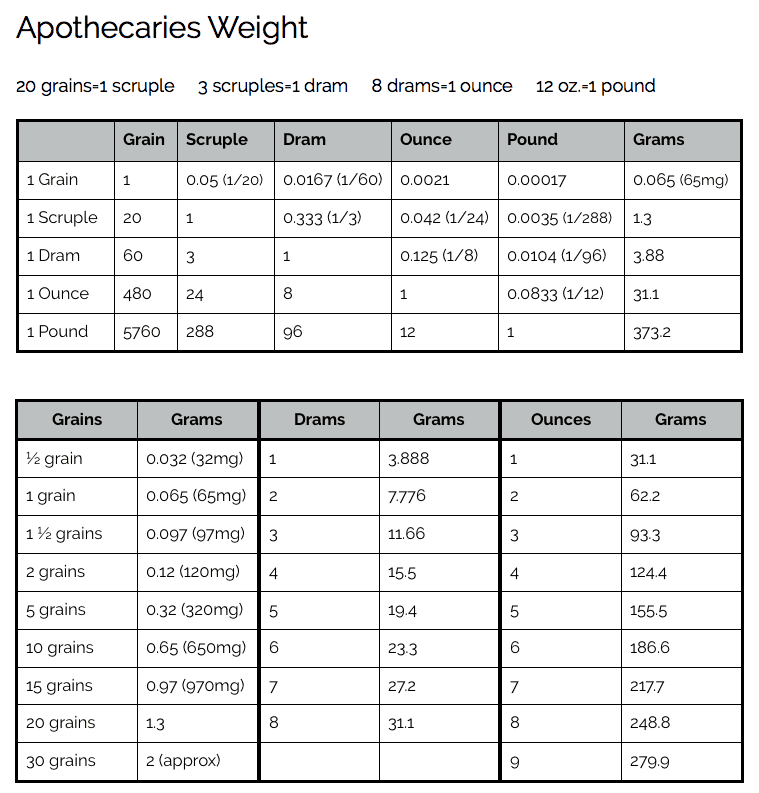
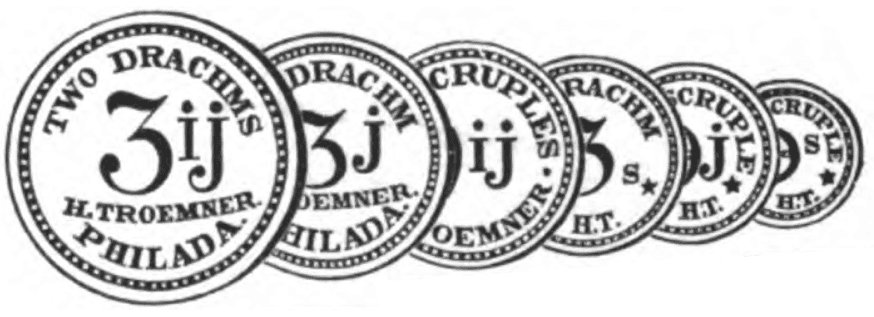
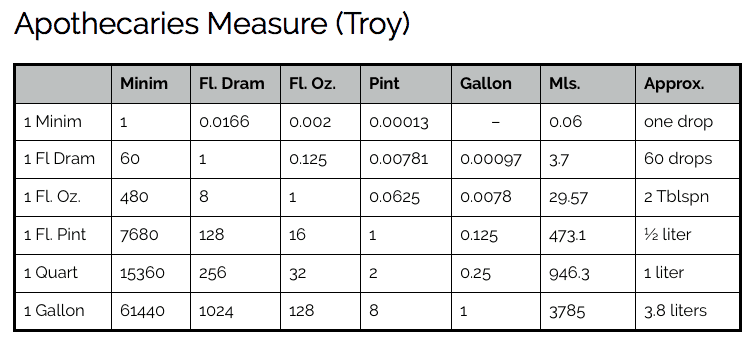
Modern Equivalents:
1 drop=1 minim (approx.)=1 fluid scruple (approx)
1 Tablespoon=3 teaspoonfuls
2 Tablespoons= 1 fluid ounce
1 fluid ounce=(rounded to) 2 tablespoons
1 cup=8 fluid ounces=(rounded to) 240mls
1 pint=1 fluid pound=2 cups=(rounded to) 500mls
1 quart=2 pints=2 fluid pounds=4 cups=(rounded to) 1 liter
1 gallon=4 quarts=8 pints
1 centiliter=0.34 fluid ounces
1 deciliter=3.38 fluid ounces
1 liter=1.06 quarts=(rounded to) 4 cups
Imperial vs US Capacity
| US | Imperial | Approx. | |
| 1 minim | 0.061 mls | 0.059 mls | 1 drop |
| 1 fluid | 3.7 mls | 3.55 mls | 3.5 mls |
| dram | 29.5 mls | 28.4 mls | 30 mls |
| 1 fluid | 473 mls | 568 mls | 500 mls |
| punce | 946 mls | 1.136 mls | 1 liter |
| 1 pint | 3.78 liter | 4.54 liters | 4 liters |
| 1 quart | |||
| 1 gallon |
The following symbols are commonly used in old medical texts to represent weights or measures, or else abbreviations relevant to the making of compounds.
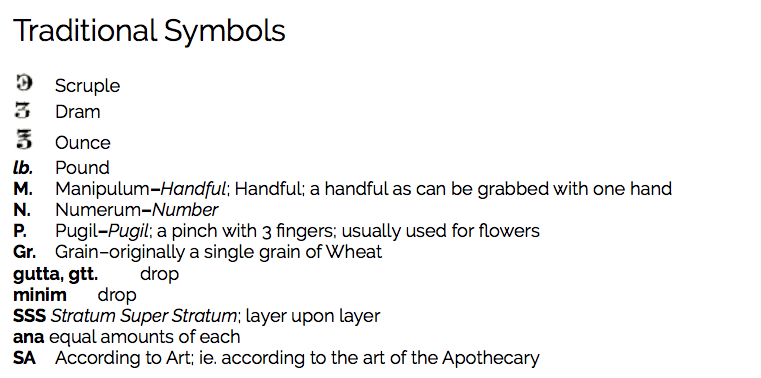
The following show the proportions of an adult dose that should be given to children according to 2 different methods
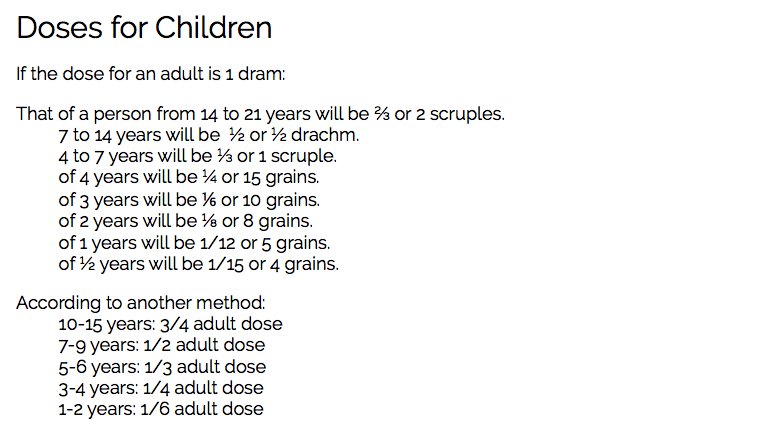
Ancient Greek / Roman Weights
Keration, Roman Siliqua
Thermos, seed of Lupin (2 keratia)
Roman Obolus (Coin)
Greek Obolos (Coin)
Gramma, Roman Scripulum, Scruple
Quanarius
Triobolon (3 Oboloi)
Drachme, Roman Drachma
Hazelnut
Denarius
Exagium (weight of a coin)
Aureos (weight of a gold coin) *see below
Walnut
Unchia, Roman Uncia (1/12 lb)
Xestes, Roman Sextans (1/6 lb)
Tetarton, Roman Quadrans (¼ lb)
Litra, Roman Libra (1 lb)
Mina, Roman Mina
0.189 grams
0.378 grams
0.568 grams
0.648 grams
1.137 grams
1.7 grams
1.794 grams
3.411 grams
3.4 grams
3.4–3.8 grams
4.55 grams
8.18 grams
13.644 grams
27.288 grams
54.58 grams
81.86 grams
327.45 grams
436.6 grams
*Weight of the Aureos was originally 8.18 grams from the time of Caesar but was reduced by later Emperors down to about 6 grams.
Ancient Greek / Roman Measures
Cheme
Concha, Small
Kyathos, Roman Cyathus (1/12 sextarius)
Oxybaphon, Roman Acetabulum
Concha, Large
Tetarton, Roman Quartarius (1/4 sextarius)
Kotyle, Roman Hemina, Semisextarius
Xestes, Roman Sextarius (1/6 Congius)
Choinix
Chus, Roman Congius
Modiu (1/3 of Amphora)
Urna, Roman Urna
Amphoreus, Roman Amphora
Metretes, Roman Metreta
11.4 ml
23 ml
45.6 ml
68.4 ml
70 ml
137 ml
274 ml
547 ml
1.094 liter
3.282 liter
8.75 liter
13.13 liter
26.26 liter
39.36 liter
Ayurvedic Weights
Rattii or Gunja
Masa (8 Ratti or Gunja)
Karsa (Tola) (12 Masa)
Sukti (2 Karsas or Tola)
Palam (2 Suktis)
Prasrti (2 Palams)
Kudava (2 Prasrti)
Manika (2 Kudava)
Prastha (2 Manika)
Adhaka (4 Prastha)
Drona (4 Adhakas)
Surpa (2 Dronas)
Droni (2 Surpas)
Khari (4 Dronis)
125 mg
1 gram
12 gram
24 grams
48 grams
96 grams
192 grams
384 grams
768 grams
3 kg., 73 grams
12 kg, 228 grams
24 kg, 576 grams
49 kg, 152 grams
196 kg, 608 grams
Arabic and Unani Weights
Some of the following weights have different amounts supplied by different sources. Some of these measurements may have been different at different times. Alternate equivalents are given in brackets.
Qirat
Daniq
Dirham
Mithqal
Awiqya (Uqiya)
Ratl
Mann
Makkuk
195 (or 223) mg
520 (or 740) mg
3.125 g (0.11 oz. avoir.)
4.46 g (or 4.68 g) (0.157 oz.)
33.85 g (1.19 oz.)
406.25 g (or 450 g) (14.32 oz., or 144 drams)
816 g
2 kg, 40 grams
